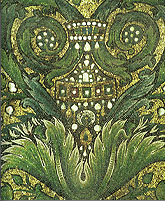|
courtesy of the Israel Museum, Jerusalem
|
|

Arab-Byzantine Coins
|
The numismatic tradition of the Early Islamic period is a direct continuation of the Byzantine and Sassanian (Persian) traditions. This is especially evident in the fact that coins minted by Justin II in the late Byzantine period were used as a prototype for Early Islamic coins; the Sassanian patterns and Persian script continued in use as well. Moreover, Early Islamic coins often bear anthropomorphic images, even of the caliph himself. The reverse of most coins was inscribed with the letter m, which had originally (in the Byzantine period) indicated the coin's value - 40 nummia. |
|
The coins minted in Jerusalem during the Early Islamic period are known as 'Arab-Byzantine' due to their combination of Byzantine features and Arabic inscriptions. These coins are marked by the Roman name of Jerusalem - Iliya - as well as the title Filastin, which denotes its military region, also including Bayt Jibrin, Ramla, Ashqalan, Amman, Gaza, Ludd (Lod) and Yubna (Yavne). The first appearance of the Arabic name of Jerusalem, Al-Quds, is on an Abbasid-period bronze coin dated to 832 CE. |

|


